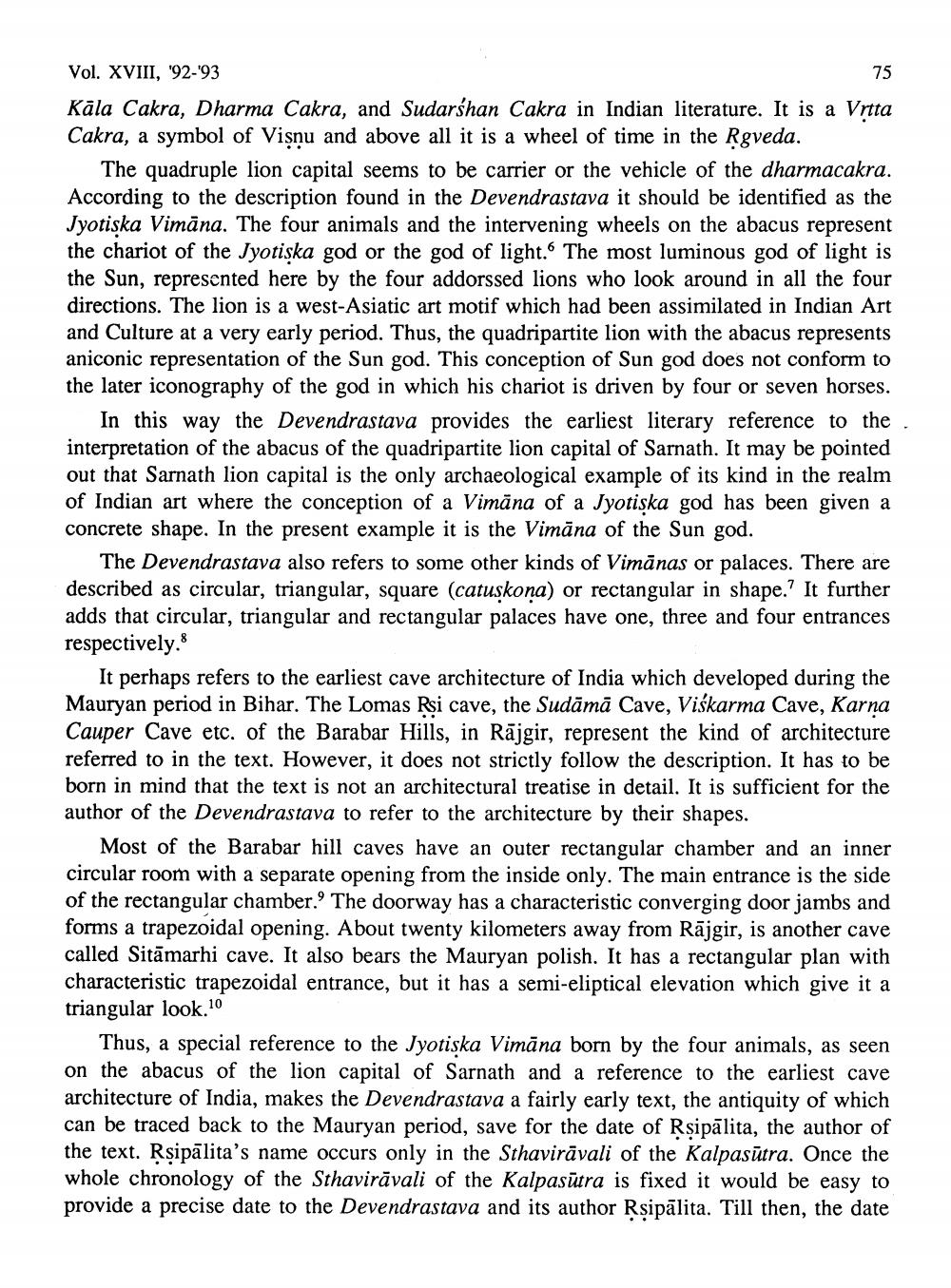________________
Vol. XVIII, '92-'93
75 Kāla Cakra, Dharma Cakra, and Sudarshan Cakra in Indian literature. It is a Vrtta Cakra, a symbol of Visnu and above all it is a wheel of time in the Rgveda.
The quadruple lion capital seems to be carrier or the vehicle of the dharmacakra. According to the description found in the Devendrastava it should be identified as the Jyotiska Vimāna. The four animals and the intervening wheels on the abacus represent the chariot of the Jyotiska god or the god of light. The most luminous god of light is the Sun, represented here by the four addorssed lions who look around in all the four directions. The lion is a west-Asiatic art motif which had been assimilated in Indian Art and Culture at a very early period. Thus, the quadripartite lion with the abacus represents aniconic representation of the Sun god. This conception of Sun god does not conform to the later iconography of the god in which his chariot is driven by four or seven horses.
In this way the Devendrastava provides the earliest literary reference to the interpretation of the abacus of the quadripartite lion capital of Sarnath. It may be pointed out that Sarnath lion capital is the only archaeological example of its kind in the realm of Indian art where the conception of a Vimāna of a Jyotiska god has been given a concrete shape. In the present example it is the Vimāna of the Sun god.
The Devendrastava also refers to some other kinds of Vimānas or palaces. There are described as circular, triangular, square (catuskona) or rectangular in shape. It further adds that circular, triangular and rectangular palaces have one, three and four entrances respectively.
It perhaps refers to the earliest cave architecture of India which developed during the Mauryan period in Bihar. The Lomas Rsi cave, the Sudāmā Cave, Viśkarma Cave, Karna Cauper Cave etc. of the Barabar Hills, in Rājgir, represent the kind of architecture
the text. However, it does not strictly follow the description. It has to be born in mind that the text is not an architectural treatise in detail. It is sufficient for the author of the Devendrastava to refer to the architecture by their shapes.
Most of the Barabar hill caves have an outer rectangular chamber and an inner circular room with a separate opening from the inside only. The main entrance is the side of the rectangular chamber. The doorway has a characteristic converging door jambs and forms a trapezoidal opening. About twenty kilometers away from Rājgir, is another cave called Sitāmarhi cave. It also bears the Mauryan polish. It has a rectangular plan with characteristic trapezoidal entrance, but it has a semi-eliptical elevation which give it a triangular look.10
Thus, a special reference to the Jyotiska Vimāna born by the four animals, as seen on the abacus of the lion capital of Sarnath and a reference to the earliest cave architecture of India, makes the Devendrastava a fairly early text, the antiquity of which can be traced back to the Mauryan period, save for the date of Rsipalita, the author of the text. Rsipālita's name occurs only in the Sthavirāvali of the Kalpasūtra. Once the whole chronology of the Sthavirāvali of the Kalpasūtra is fixed it would be easy to provide a precise date to the Devendrastava and its author Rsipalita. Till then, the date




